The PHENOLEXA consortium met in full on May 15 and 16 at the CARTIF technology centre facilities to hold the last meeting of the project and thus recapitulate the results achieved after three years of research and development.
This initiative arose with the aim of developing a base technology for the deployment of a cascade biorefinery process that would efficiently extract and preserve polyphenolic compounds from four types of residual biomass: olive and grape pruning residues and leaves, onion peel, and chicory root leaves. Combining laboratory and pre-industrial scale (TRL 4/5), the PHENOLEXA project has demonstrated 12 technologies over the past months:
- Four innovative waste biomass pretreatment technologies: microbial, fungal, ultrasonic and pulsed electric fields.
- Two technologies for the extraction of polyphenolic bioactive compound: with natural and deep eutectic solvents (NADES) and with subcritical water.
- Two purification technologies: membrane filtration and centrifugal partition chromatography (CPC).
- One functionalization technique: modification and derivatization of flavonoid and phenolic acids.
- Three microencapsulation and stabilization technologies: spray drying, membrane emulsification and droplet coacervation.
Another of the actions carried out within the framework of the project has been the complete in vitro and in vivo characterization of the bioactives obtained from which prototypes of cosmetic, nutraceutical, pharmaceutical and functional food products have been created including these compounds obtained during the development of the project.
Likewise, the techno-economic feasibility and sustainability of the biorefinery process has also been validated, evaluating environmental indicators –such as carbon footprint-, and social indicators –such as health and safety in the agricultural sector-.
The CARTIF research team involved in this project has been in charge of the inventory of this residual biomass and the development of its possible supply chain in Europe; it has demonstrated, at laboratory level, the feasibility of the encapsulation of bioactive compounds by spray drying, as well as the environmental and socio-economic evaluation of the technological processes studied in the project.
PHENOLEXA is a research and innovation project whose objective has been to develop a safe, efficient and environmentally friendly cascade biorefinery process to obtain high value polyphenolic bioactive compounds (CBA) with preserved, adapted and/or improve functionality with specific biological activities for use in pharmaceuticals, nutraceuticals and cosmetics.
According to Eurostat, the agricultural sector is by far the largest producer of residual biomass in Europe, generating some 400 million tons (Mt) of dry agricultural waste annually. This residual biomass is often used for low-value applications (compost of animal feed). However, it is very rich in various bioactive compounds (polyphenols among others) that could be used to improve the health and well-being of society, but it is often wasted for high-value applications due to the lack of comprehensive technology to effectively extract and preserve the bioactives.
Within this framework, the PHENOLEXA project emerged, which began in June 2021 and concluded this May after three years of work, bringing together a team of 12 European partners from Spain, the United Kingdom, Italy, Belgium, Germany, France, Estonia and Poland. The total budget of the project was 4.6 million euros, with a contribution of 3.9 million euros from the BBI Joint Undertaking.
